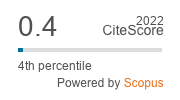Compound eyes of Camponotus compressus (Fabricius, 1798) (Hymenoptera, Formicidae) reflects caste specific organisation and adaptation
DOI:
https://doi.org/10.33307/entomon.v49i2.1168Abstract
Caste polymorphs of the ant Camponotus compressus (Fabricius, 1798) are distinct by their morphology and life styles; the two distinct castes are largely nocturnal and rely on their visual sensory system to interpret their temporal niches. The compound eyes of the castes were explored through Light and Scanning Electron Microscopy (SEM) in order to delineate cast specific organisation and adaptations of the compound eye. The findings reveal that major workers of C. compressus possess a more sophisticated visual system in terms of its morphological features along with optical properties that enhances a better vision, which includes a greater number of ommatidia and high ommatidial density, a higher ommatidial diameter, low inter ommatidial angle and a more efficient pupillary mechanism to counter conditions where ambient light levels are high. This underlines the dependence of scouts (major workers) on visual system and the foragers on olfactory system in the species.
Downloads
Published
How to Cite
Issue
Section
License
Copyright (c) 2024 Association for Advancement of Entomology

This work is licensed under a Creative Commons Attribution-ShareAlike 4.0 International License.


